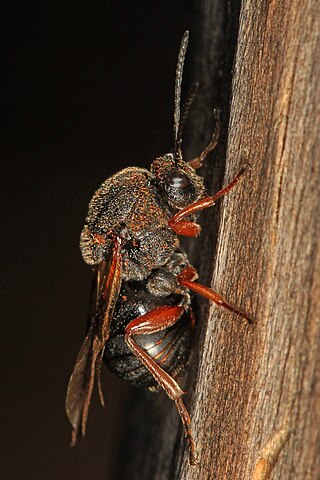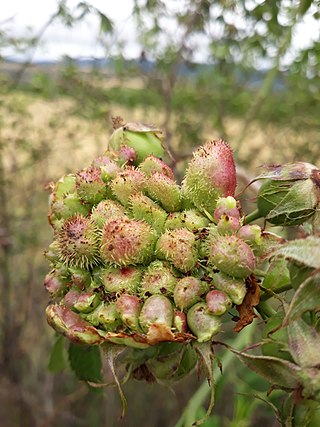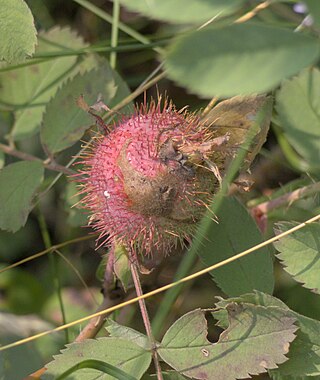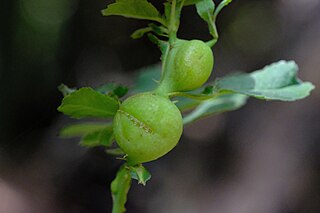Galls or cecidia are a kind of swelling growth on the external tissues of plants. Plant galls are abnormal outgrowths of plant tissues, similar to benign tumors or warts in animals. They can be caused by various parasites, from viruses, fungi and bacteria, to other plants, insects and mites. Plant galls are often highly organized structures so that the cause of the gall can often be determined without the actual agent being identified. This applies particularly to insect and mite plant galls. The study of plant galls is known as cecidology.

Diplolepis is a genus of approximately fifty species of gall-inducing wasps in the family Diplolepididae. The larvae induce galls on wild roses (Rosa), and rarely on domestic roses.

Gall wasps, also traditionally calledgallflies, are hymenopterans of the family Cynipidae in the wasp superfamily Cynipoidea. Their common name comes from the galls they induce on plants for larval development. About 1,300 species of this generally very small creature are known worldwide, with about 360 species of 36 different genera in Europe and some 800 species in North America.

Rosa nutkana, the Nootka rose, bristly rose, or wild rose is a 0.6–3.0-metre-tall (2–10-foot) perennial shrub in the rose family (Rosaceae).

Aprostocetus is a genus of hymenopteran insects of the family Eulophidae. The genus was erected by John O. Westwood in 1833. This very large group of parasitoid wasps has a global distribution.

Diplolepis rosae is a gall wasp which causes a gall known as the rose bedeguar gall, bedeguar gall wasp, Robin's pincushion, mossy rose gall, or simply moss gall. The gall develops as a chemically induced distortion of an unopened leaf axillary or terminal bud, mostly on field rose or dog rose shrubs. The female wasp lays up to 60 eggs within each leaf bud using her ovipositor. The grubs develop within the gall, and the wasps emerge in spring; the wasp is parthenogenetic with fewer than one percent being males.

Rosa pisocarpa is a species of rose known by the common name cluster rose or swamp rose. It is native to western North America from British Columbia to northern California, where it generally grows in moist habitats. It is a shrub sometimes forming a thicket, and growing up to 2.5 meters tall. The stems can be dark red or blackish and are often studded with straight, paired prickles at nodes. The leaves are each made up of several toothed oval leaflets, the terminal leaflet up to 4 centimeters long. The inflorescence is a cyme of up to 10 flowers with pink petals each up to 2 centimeters in length. The fruit is a rose hip about a centimeter wide. The hips are pear- or egg-shaped and borne in clusters, and are decorative in fall and early winter, when they are red or reddish-purple and contrast with yellow foliage. Fall foliage can be yellow or dark red.

Diplolepis mayri is a gall inducing insect causing galls on wild roses in the Western Palaearctic. Diploleis mayri is less frequent on rose shrubs than D. rosae.

Disholcaspis is a genus of gall wasps in the family Cynipidae. There are more than 40 species described in the genus Disholcaspis. Some Disholcaspis species induce galls that produce honeydew, a sweet liquid that attracts yellow jackets, ants, and bees. These insects then protect the galls from parasitic wasps.

Diplolepis fructuum is a hymenopteran gall wasp which causes a galls on wild roses. The species is closely related to D. rosae and D. mayri but it produces its galls in the seeds of wild roses thus damaging its hips. The species is distributed mainly in the Northern regions of the Middle East, the Caucasus region and Northern shores of the Black Sea.

Diplolepis polita, known generally as the spiny leaf gall wasp, is a species of gall wasp in the family Cynipidae. It was first described by William Harris Ashmead in 1890.

Diplolepis ignota is a species of gall wasp (Cynipidae). Galls in which the larvae live and feed are formed on the leaves of several species of wild rose (Rosa). Individual galls are single-chambered and spherical, but multiple galls can coalesce into irregularly rounded galls.

Diplolepis californica, formerly Rhodites californicus, also known as the leafy bract gall wasp, is a species of cynipid wasp that induces galls on wild roses on the Pacific coast of North America. D. californica induces club-shaped bud galls that naturalist Richard A. Russo describes as "distinguished from all others by the flat, leafy lobes that emanate from the main gall body and look like aborted leaflets". Each gall contains multiple larval chambers. One of host plants of the leafy bract gall wasp is Rosa californica.

Diplolepis bicolor, also known as the spiny bud gall wasp, is a species of cynipid wasp that induces bud galls on wild roses. This gall wasp is found throughout North America. The galls measure 10 to 12 mm in diameter and have a superficial resemblance to the leaf galls induced by Diplolepis polita.

Diplolepis spinosa, also known as the many-spined twig gall wasp, is a species of cynipid wasp that induces galls on wild roses in North America. D. spinosa-induced galls are said to be "one of the most conspicuous" found in the grasslands of the continent.

Diplolepis nodulosa, also known as the rose-stem gall wasp, is a species of cynipid wasp that induces bud galls on wild roses in North America. This galls induced by this species have a number of inquilines and parasitoids. D. nodulosa is assigned to a clade of Nearctic stem gallers within Diplolepis along with Diplolepis californica, Diplolepis oregonesis, Diplolepis spinosa, and Diplolepis triforma.

Diplolepididae is a family of small gall-inducing wasps. Until recently these wasps were included in the gall wasp family (Cynipidae) but were moved to their own family based on genetic and morphological features. It contains two subfamilies: Diplolepidinae and Pediaspidinae.














